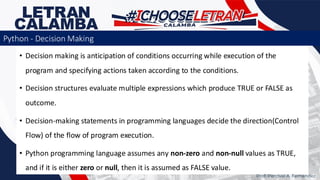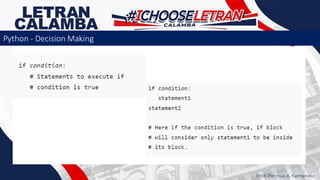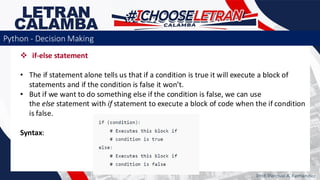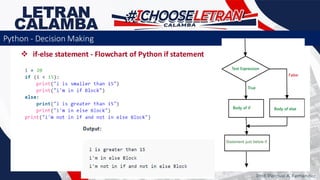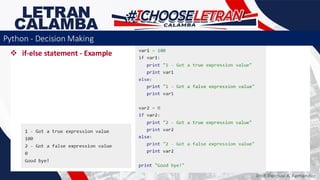Module 2-Review of Python Decision making and Loops.pdf
- 1. ADVANCED PYTHON PROGRAMMING Lec: CSDS042 Lab: CSDS041L Prof. Percival A. Fernandez
- 3. • Decision making is anticipation of conditions occurring while execution of the program and specifying actions taken according to the conditions. • Decision structures evaluate multiple expressions which produce TRUE or FALSE as outcome. • Decision-making statements in programming languages decide the direction(Control Flow) of the flow of program execution. • Python programming language assumes any non-zero and non-null values as TRUE, and if it is either zero or null, then it is assumed as FALSE value. Python - Decision Making Prof. Percival A. Fernandez
- 4. Types of Control Flow in Python In Python programming language, the type of control flow statements are as follows: 1.The if statement 2.The if-else statement 3.The nested-if statement 4.The if-elif-else ladder Prof. Percival A. Fernandez Python - Decision Making
- 5. Python programming language provides following types of decision making statements Prof. Percival A. Fernandez Python - Decision Making
- 6. ❖ if statement The if statement is the most simple decision-making statement. It is used to decide whether a certain statement or block of statements will be executed or not. Syntax: Prof. Percival A. Fernandez Python - Decision Making
- 7. ❖ if statement • Here, the condition after evaluation will be either true or false. if the statement accepts boolean values • – if the value is true then it will execute the block of statements below it otherwise not. • As we know, python uses indentation to identify a block. So the block under an if statement will be identified as shown in the below example: Prof. Percival A. Fernandez Python - Decision Making
- 8. Prof. Percival A. Fernandez Python - Decision Making
- 9. ❖ if statement - Flowchart of Python if statement Prof. Percival A. Fernandez Python - Decision Making
- 10. ❖ if statement - Example Prof. Percival A. Fernandez Python - Decision Making
- 11. ❖ if-else statement • The if statement alone tells us that if a condition is true it will execute a block of statements and if the condition is false it won’t. • But if we want to do something else if the condition is false, we can use the else statement with if statement to execute a block of code when the if condition is false. Syntax: Prof. Percival A. Fernandez Python - Decision Making
- 12. Python - Decision Making ❖ if-else statement - Flowchart of Python if statement Prof. Percival A. Fernandez
- 13. ❖ if-else statement - Example Prof. Percival A. Fernandez Python - Decision Making
- 14. ❖ nested-if statement • A nested if is an if statement that is the target of another if statement. • Nested if statements mean an if statement inside another if statement. • Yes, Python allows us to nest if statements within if statements. i.e, we can place an if statement inside another if statement. Syntax: Prof. Percival A. Fernandez Python - Decision Making
- 15. ❖ nested-if statement - Flowchart of Python Nested if Statement Prof. Percival A. Fernandez Python - Decision Making
- 16. ❖ nested-if statement – ❖ Flowchart of Python ❖ Nested if Statement Prof. Percival A. Fernandez Python - Decision Making
- 17. ❖ nested-if statement - Example Prof. Percival A. Fernandez Python - Decision Making
- 18. ❖ if-elif-else ladder • Here, a user can decide among multiple options. The if statements are executed from the top down. As soon as one of the conditions controlling the if is true, the statement associated with that if is executed, and the rest of the ladder is bypassed. • If none of the conditions is true, then the final else statement will be executed. Syntax: Prof. Percival A. Fernandez Python - Decision Making
- 19. ❖ if-elif-else ladder – ❖ Flowchart of Python ❖ if-elif-else ladder Prof. Percival A. Fernandez Python - Decision Making
- 20. ❖ if-elif-else ladder – ❖ Flowchart of Python if-elif-else ladder Prof. Percival A. Fernandez Python - Decision Making
- 21. ❖ if-elif-else ladder - Example Prof. Percival A. Fernandez Python - Decision Making


